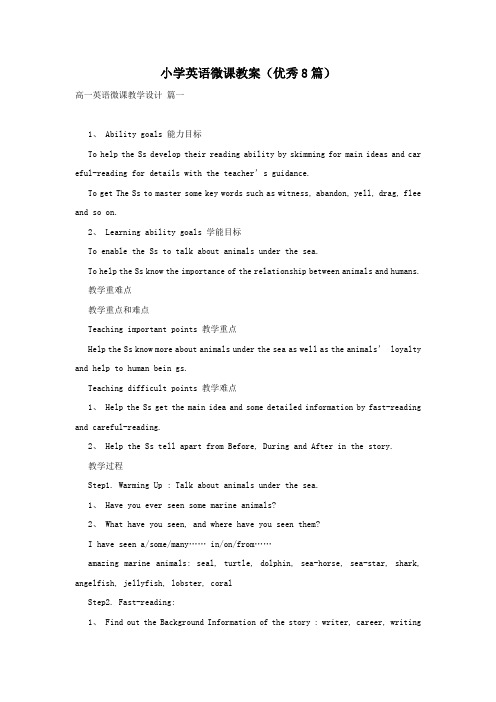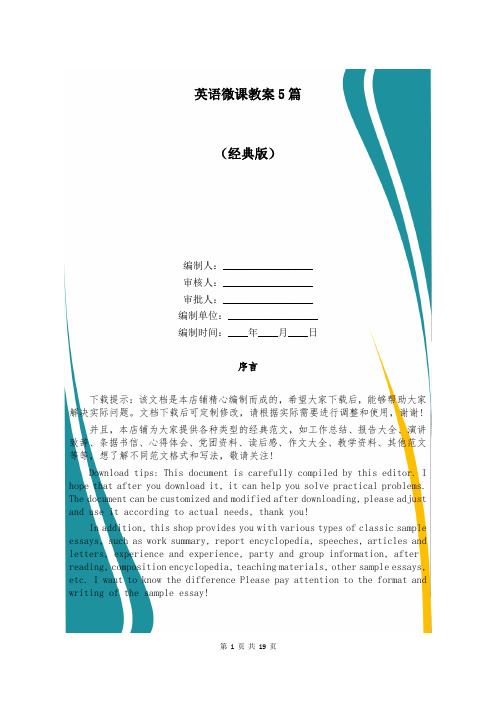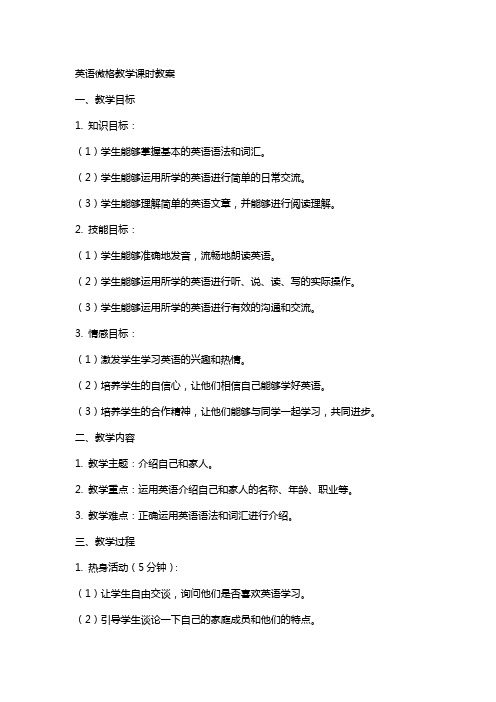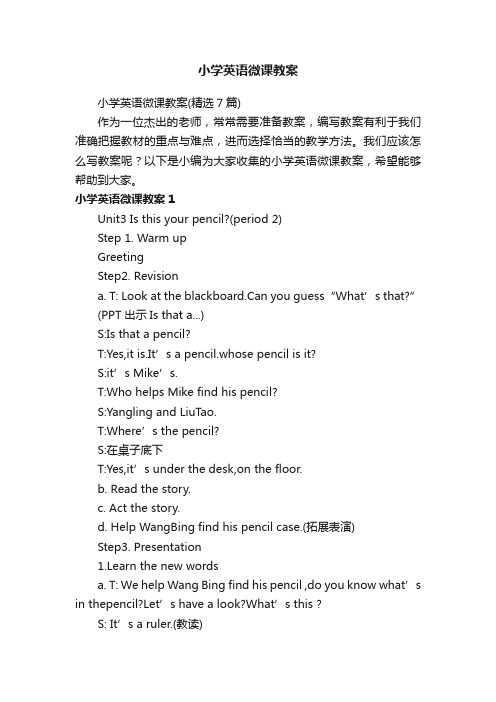小学英语微型课教案
小学英语微课设计教案5篇

小学英语微课设计教案5篇小学英语微课设计教案篇1一、教学目标学问目标:1. 学会使用句型“What did you do at the weekend?”和“Where did you go?”并懂得使用相应的过去式进行对话。
2. 能有感情地朗读课文,并进行角色扮演。
3. 能用动词过去式询问上周末的活动情况。
能力目标:1.会用“What did you do at the weekend?”和“Where did you go?”询问过去发生的事情。
2.通过活动体验,在交流中学会谈论上周末从事的活动,谈论不久前发生的事情,发展综合语言运用能力。
提高学生跨文化交际意识。
情感目标:培养学生学习兴趣,鼓励学生乐观合作,引导学生了解西方文化古迹,树立旅游意识。
二、教学重点与难点教学重点:1. 能听懂、会说并能熟练使用单词weekend, place, trip, along, river, twenty, minute, hour, best以及词组the British Museum, bus ride.2. 能听懂、会说并能熟练使用句子What did you do at the weekend? 和Where did you go?教学难点:能够在真实情境中对单词、词汇及句型进行综合的运用。
三、教学方法1. 通过老师引导示范,学生自主识记,小组合作,朗读合作等多种形式,使学生读懂文章并把握重难句的实际运用。
2. 通过两两对话提高学生学习英语策略及口语交际能力。
3. 通过“争当小记者”活动激发并保持学生学习英语兴趣。
四、教学预备课件,Flash视频,词卡,Daming和Amy头像,记者证五、教学过程Step1: Warming-up1) Greet to the students.2) Listen a song“Where did you go?”唱关于旅游的歌曲,为新课做铺垫。
Step2: Lead-in1)老师出示自己的旅游照。
小学英语微课教学设计(通用6篇)

小学英语微课教学设计小学英语微课教学设计(通用6篇)作为一名为他人授业解惑的教育工作者,常常要写一份优秀的教学设计,借助教学设计可以让教学工作更加有效地进行。
那么写教学设计需要注意哪些问题呢?下面是小编收集整理的小学英语微课教学设计(通用6篇),欢迎大家借鉴与参考,希望对大家有所帮助。
小学英语微课教学设计1新学期要有新气象,作为教师也不例外。
为了更好的开展六年级的英语学习,加强班级同学们的英语词汇量与英语素养,给身处六年级冲刺阶段的学生们多增添一份力量。
为此,我在这新学期伊始之时,特意制定此英语教学工作计划如下:一、所带班级情景分析这学期我所带领的班级依然是xx班,此班级的班风较为活泼,在课堂互动上也较为活跃。
可是相对的是纪律方面有所缺陷,幸而对于教学并不会构成太大影响。
可是从上个学期的期末考试成绩上和一向以来的认识来看,班级内有数量较多的同学英语成绩波动较大,在英语词汇的积累与应用上还具有一些缺陷需要弥补,而这些都是我在这新的学期里需要注意和加强的地方。
二、针对性教学方案在这个学期我除了传统上课教学下课练习模式外,还会额外添加一些英语歌曲与英语故事的教学,尝试经过趣味性的教学方式来提高班级同学们的词汇量,提高同学们对英语这一课程的理解度与自主性。
同时,因为这是小升初的考试之前的最终一学年,也是最终的冲刺准备阶段,所以我除了这些教学以外还会加强模拟考试等练习,并经过研究历年考试真题来进行有针对性的考前培训,提高学生的答题技巧以及知识运用本事。
三、个人教学工作准备1、加强自身学习研究,经过历年的考试真题来对考试可能会出现的题型题目进行一些预测,并针对预测结果来进行教学准备,以提高学生的考试本事。
2、加强与孩子们的沟通交流,明白他们学习的难点在哪里,了解自我在教学中的不足并加以改正,力求经过这种方式来让我于班级同学融为一体,共同加强学习,共同为了提高而努力奋斗。
3、一个班级中总是有成绩的高低,所以我要发挥出教师的耐心与本事来悉心教导,不抛弃任何一个学生,督促先进生,鼓励后进生,引导整个班级学习风气的前进。
小学英语微课教案(优秀8篇)

小学英语微课教案(优秀8篇)高一英语微课教学设计篇一1、 Ability goals 能力目标To help the Ss develop their reading ability by skimming for main ideas and car eful-reading for details with the teacher’s guidance.To get The Ss to master some key words such as witness, abandon, yell, drag, flee and so on.2、 Learning ability goals 学能目标To enable the Ss to talk about animals under the sea.To help the Ss know the importance of the relationship between animals and humans.教学重难点教学重点和难点Teaching important points 教学重点Help the Ss know more about animals under the sea as well as the animals’ loyalty and help to human bein gs.Teaching difficult points 教学难点1、 Help the Ss get the main idea and some detailed information by fast-reading and careful-reading.2、 Help the Ss tell apart from Before, During and After in the story.教学过程Step1. Warming Up : Talk about animals under the sea.1、 Have you ever seen some marine animals?2、 What have you seen, and where have you seen them?I have seen a/some/many…… in/on/from……amazing marine animals: seal, turtle, dolphin, sea-horse, sea-star, shark, angelfish, jellyfish, lobster, coralStep2. Fast-reading:1、 Find out the Background Information of the story : writer, career, writingstyle, time, place, main character.2、 Find out the Main Idea of the passage: What’s the first story mainly about? Step3. Careful-reading:1、 Clancy had heard of the killer whales that every year killer whales would help whalers catch baleen whales. Did he believe it at first? When did he believe it was a true anecdote?2、 How many paragraphs are there all together in story1? The hunt can be divided into 3 stages.Stage1: before the hunt: (para. 2-6):Old Tom’s doing: throwing itself out of … and crashing down again… Why? to tell the whalers…,…by the boat…, circling back to …Why? to lead the whalers… Whalers’ reaction: Another whaler __________. George _____ ___ _____ Clancy, and Clancy ______ after him. They __________ the boat and ______ ____into the bay. Stage23: Dur ing and after the hunt: (para. 7-9):Killer whale’s doing: The killers over there are ________ themselves on the top of the whale’s blow-hole to stop it __________; and some others are stopping it _______ out to sea. The killers started ________ between our boat and the whale just like a pack of ____ ___ dogs. When the baleen whale was dead, its body wa s _______ down into the depths of the sea.Whalers’ reaction: The man in the bow of the boat aimed the harpoon at the whale and then let it go to hit the spot.Conclusion: They have amazing relationship. They work as a teamStep4 : SummaryWorking at the _______station, I had the chance to _________ a baleen whale being attacked by a ______ of k iller whales.On the afternoon I arrived at the station, as I was __________ my accommodation, I heard a loud noise coming from the bay. I ran down to the ______ in time to see an enormous animal _________ itself out of the water and then _______________ again. George told me it was Old Tom, who announced there would be a ___________.Using a _________, we could see a baleen whale _______________ by about sixkillers. Some are ________ themselves on top of the whale’s __________to stop it breathing; and some others are stopping it _______ out to sea. The whalers aimed the ________ at the whale and then let it go to hit the spot. Being badly ________, the whale soon died. Very soon, its body was ________ by the killers down into the _______ of the sea.课后习题课后作业Deal with Exercise 3 in Comprehending 。
英语微课教案5篇

英语微课教案5篇(经典版)编制人:__________________审核人:__________________审批人:__________________编制单位:__________________编制时间:____年____月____日序言下载提示:该文档是本店铺精心编制而成的,希望大家下载后,能够帮助大家解决实际问题。
文档下载后可定制修改,请根据实际需要进行调整和使用,谢谢!并且,本店铺为大家提供各种类型的经典范文,如工作总结、报告大全、演讲致辞、条据书信、心得体会、党团资料、读后感、作文大全、教学资料、其他范文等等,想了解不同范文格式和写法,敬请关注!Download tips: This document is carefully compiled by this editor. I hope that after you download it, it can help you solve practical problems. The document can be customized and modified after downloading, please adjust and use it according to actual needs, thank you!In addition, this shop provides you with various types of classic sample essays, such as work summary, report encyclopedia, speeches, articles and letters, experience and experience, party and group information, after reading, composition encyclopedia, teaching materials, other sample essays, etc. I want to know the difference Please pay attention to the format and writing of the sample essay!英语微课教案5篇为了避免在教学过程中出错,提前制定好教案是非常重要的,一份实用的教案是需要结合实际的教学内容和教学能力的,下面是本店铺为您分享的英语微课教案5篇,感谢您的参阅。
英语微格教学课时教案

英语微格教学课时教案一、教学目标1. 知识目标:(1)学生能够掌握基本的英语语法和词汇。
(2)学生能够运用所学的英语进行简单的日常交流。
(3)学生能够理解简单的英语文章,并能够进行阅读理解。
2. 技能目标:(1)学生能够准确地发音,流畅地朗读英语。
(2)学生能够运用所学的英语进行听、说、读、写的实际操作。
(3)学生能够运用所学的英语进行有效的沟通和交流。
3. 情感目标:(1)激发学生学习英语的兴趣和热情。
(2)培养学生的自信心,让他们相信自己能够学好英语。
(3)培养学生的合作精神,让他们能够与同学一起学习,共同进步。
二、教学内容1. 教学主题:介绍自己和家人。
2. 教学重点:运用英语介绍自己和家人的名称、年龄、职业等。
3. 教学难点:正确运用英语语法和词汇进行介绍。
三、教学过程1. 热身活动(5分钟):(1)让学生自由交谈,询问他们是否喜欢英语学习。
(2)引导学生谈论一下自己的家庭成员和他们的特点。
2. 引入新课(10分钟):(1)向学生介绍本节课的主题:介绍自己和家人。
(2)展示一些与家庭成员相关的图片,让学生猜测他们的关系。
3. 讲解和示范(10分钟):(1)讲解如何用英语介绍自己和家人的名称、年龄、职业等。
(2)示范如何用英语进行自我介绍和介绍家人。
4. 实践环节(10分钟):(1)让学生分成小组,用英语进行自我介绍和介绍家人。
(2)鼓励学生大胆开口,注重语音语调的准确性。
5. 巩固环节(5分钟):(1)让学生在班级内进行角色扮演,模拟真实场景进行自我介绍和介绍家人。
(2)邀请部分学生到讲台前进行表演,给予表扬和鼓励。
四、作业布置1. 让学生用英语写一篇关于自己和家人的介绍短文。
2. 让学生复习本节课所学的词汇和语法,准备下一节课的测试。
五、教学反思2. 对教学方法和教学内容进行反思,看是否需要进行调整。
3. 思考如何激发学生的学习兴趣,提高他们的学习积极性。
六、教学评估1. 课堂观察:观察学生在课堂上的参与程度、发音准确性以及语言流畅性。
小学英语微课教案(精选7篇)

小学英语微课教案小学英语微课教案(精选7篇)作为一位杰出的老师,常常需要准备教案,编写教案有利于我们准确把握教材的重点与难点,进而选择恰当的教学方法。
我们应该怎么写教案呢?以下是小编为大家收集的小学英语微课教案,希望能够帮助到大家。
小学英语微课教案1Unit3 Is this your pencil?(period 2)Step 1. Warm upGreetingStep2. Revisiona. T: Look at the blackboard.Can you guess“What’s that?”(PPT出示Is that a...)S:Is that a pencil?T:Yes,it is.It’s a pencil.whose pencil is it?S:it’s Mike’s.T:Who helps Mike find his pencil?S:Yangling and LiuTao.T:Where’s the pe ncil?S:在桌子底下T:Yes,it’s under the desk,on the floor.b. Read the story.c. Act the story.d. Help WangBing find his pencil case.(拓展表演)Step3. Presentation1.Learn the new wordsa. T: We help Wang Bing find his pencil ,do you know what’s in thepencil?Let’s have a look?What’s this ?S: It’s a ruler.(教读)The same way teach: crayon ,school bagb.Play a game (review words)c.Spell the wordsd.Show the stationaries to classmates:This is my...That’s my...2.Play a game: Fun timea. Answer the questionb. Play a game (出示游戏方法,让学生知道该怎么玩游戏)c. Consolidation失物招领T: This morning.I got sth.in the classroom,whose are they ?Can you help mefind their owner?(事先收集一下同学的学习用品)S:(学生帮老师寻找失主)T:Good job! I hope everyone can be helpful to your classmates.d.Learn: Rhyme timeOh,here’s a ruler too,is this your ruler?S;No,it isn’t.T:Where’s the ruler?S: 在地上T:Yes,it’s on the floor.(教读) 板书floorT: Where’s the ruler?S:It’s on the floorT: It’s on the floor,beside the door (教读) 板书doorT(出示图片)Who’s he ?He’s Mr.Fuller.(教读)Let’s say“Hello” to Mr. Fuller.S: Hello,Mr. Fuller.T:Let’s learn this rhyme ,its name is “A ruler”出示歌谣句子,逐句跟读,跟节奏伴读。
《英语微型课教案》
《英语微型课教案》word版一、课程概述本课程旨在通过微型课的形式,帮助学生快速掌握英语基础知识,提高英语听说读写能力。
课程内容涵盖单词、短语、句子、语法、听力、口语、阅读和写作等多个方面,旨在为学生提供一个全面、系统的英语学习平台。
二、教学目标1. 让学生掌握一定数量的英语单词和短语,提高词汇量。
2. 培养学生具备基本的英语语法知识,能正确运用语法进行表达。
3. 提高学生的英语听力、口语、阅读和写作能力。
4. 培养学生的英语思维能力和跨文化交际能力。
三、教学内容1. 单词和短语的学习:通过讲解和练习,使学生掌握课程中出现的单词和短语。
2. 语法知识的学习:通过实例分析和练习,使学生掌握基本的英语语法知识。
3. 听力训练:通过听英语短文、对话或故事,提高学生的英语听力水平。
4. 口语练习:通过角色扮演、情景对话等方式,提高学生的英语口语能力。
5. 阅读理解:通过阅读英语文章,提高学生的英语阅读理解能力。
6. 写作技巧:通过讲解和练习,使学生掌握英语写作的基本技巧和方法。
四、教学方法1. 讲授法:教师讲解单词、短语、语法知识等。
2. 互动式教学:教师与学生进行口语练习、听力训练等。
3. 任务型教学:学生通过完成具体任务,提高英语实际运用能力。
4. 小组合作学习:学生分组进行讨论、练习,促进相互学习、共同进步。
五、教学评价1. 平时成绩:根据学生的课堂表现、作业完成情况等给予评价。
2. 单元测试:每个单元结束后进行测试,检验学生的学习效果。
3. 期末考试:全面考察学生的英语听说读写能力。
4. 学生互评:学生之间进行相互评价,促进彼此的学习。
六、教学资源1. 教材:选用适合学生水平的英语教材,如《新概念英语》、《牛津英语》等。
2. 辅助材料:提供单词卡片、语法图表、听力材料、口语练习剧本等。
3. 多媒体资源:利用PPT、视频、音频、网络资源等,丰富教学手段,提高学生的学习兴趣。
4. 网络资源:引导学生利用网络资源进行自主学习,如英语学习网站、在线课程等。
小学英语微教案模板(共5篇)
小学英语微教案模板〔共5篇〕第1篇:小学英语微课教案小学英语微课教案模板【篇1:人教版小学英语微课教学设计】人教版小学英语微课教学设计主题名称:be动词的用法教学目标:学生能掌握be动词的三种根本形式,总结出用法规律并能正确使用。
教学过程:一、导入:be动词神通广阔,像孙悟空一样变化多端,能变成‘am , is , are’三种形式,孙悟空降服不一样的妖魔,变换成不同的模样,be动词也一样,主语不同,变成的样子也不同。
设计意图:充分激发学生的兴趣,集中学生注意力。
二、引导新授:通过观察理解句子,学生自行总结规律,教师补充讲解。
i am a student.我用amyou are a teacher.你用are she is my mother.he is my father.is连着她他它 it is a monkey.my name is amy.单数形式用isthey are my friends.看到复数那么用are设计意图:充分发挥学生的主体作用,培养学生的观察能力。
三、练习稳固:1.〔〕you from china ? yes , i〔〕.2.where ( ) he from ?3.how ( ) it going ?4.( ) this your mother?5.( ) they baibai and tutu ? no , they ( ) not .we ( ) good friends .设计意图:通过相应练习稳固新授内容,检测学生的掌握情况,同时便于学生查缺补漏,加深印象,同时练习设计多为疑问句,学生能活学活用。
四、规律升华:我用am ,你用are ,is 连着她他它,单数形式用is,看到复数那么用are,变疑问,be提前,句末问号莫相忘。
设计意图:以chant形式帮助记忆be动词用法。
【篇2:微课设计小学英语四年级上册第13教学微课教学设计方案】小学英语四年级上册第13课教学微课教学设计方案【篇3:小学英语微课程设计方案】第2篇:少儿英语教案模板少儿英语教案模板一、Teaching Demands and Aims(教学目标〕二、Teaching important and difficult point (教学重点〕1、words2、sentences3、grammars三、Teaching Aids (教具)四、Teaching procedures(教学过程〕 Greeting(问候〕 warm up(热身〕Review(复习〕 New Leon(新课〕 Step One: Step Two: Step Three: Follow up(叮咛〕五、Homework(作业布置〕作业的布置一、书面作业1、每节课后教师可适中选择课后习题(书本或课外参考书〕及字母作业。
小学英语微课设计教案
小学英语微课设计教案小学英语微课设计教案篇1教学目标1. 语言知识目标:1) 能掌握以下单词:rules, arrive, late, hall, dinning hall, listen, listen to, fight, sorry2) 能掌握以下句型:① Dont eat in class.② You must be on time.③ Eat in the dining hall.2. 学会用英语表达一些标志的含义。
3. 熟练使用目标语言谈论对某些规章制度(校规、家规等)的看法3. 情感态度价值观目标:能用英语表达和制定一些简单的规则,理解没有规矩不成方圆;无论是在学校时还是在家庭中以及以后走上社会都应当遵守规则,按规则办事。
教学重难点1. 教学重点:1) 肯定祈使句是省略掉主语的原形动词开头;2) 否定祈使句则是在肯定祈使句前加上“don’t”。
3) 情态动词must及have to在用法上的区别。
2. 教学难点:掌握祈使句的用法,并能听懂、会说一些简单的祈使句。
教学工具多媒体教学过程Ⅰ. Warming-up and revision教师进教室后,使用祈使句请学生们完成一系列动作:Please stand up/ sit down. Close the door, please. Look at me and listen to me.Don’t open your books. Don’t talk. Let’s begin our class.学生听教师的指令完成各种动作,教师也可将指令写到黑板上,让学生从视觉上考察祈使句的特点。
Ⅱ. Presentation教师出示书上1a 的图片,向学生提问。
指着图上奔跑的男孩提问T:What’s the boy doing? S: He’s running.T: Where is he running? S: He’s running in the hallways.(板书,教读)T:Can you run in the hallways? S: No, I can’t.T: So please don’t run in the hallways.(板书,教读)(= You can’t run in the hallways.)学生跟读数遍,明白祈使句和“can”的表达含意。
《英语微型课教案》
《英语微型课教案》一、课程简介本课程旨在通过微型课的形式,帮助学生快速掌握英语基础知识,提高英语听、说、读、写能力。
课程内容涵盖词汇、语法、发音、听力、口语、阅读和写作等方面,通过实用、有趣的教学活动,激发学生学习英语的兴趣和自信心。
二、教学目标1. 掌握一定的英语词汇和语法知识。
2. 提高英语听力和口语能力。
3. 提升英语阅读和写作技巧。
4. 增强学生学习英语的兴趣和自信心。
三、教学方法1. 任务型教学法:通过完成各种实际任务,让学生在实践中学习英语。
2. 情景教学法:创设真实的语境,让学生在具体情境中学习英语。
3. 游戏教学法:通过趣味游戏,激发学生学习英语的兴趣。
4. 小组合作学习:鼓励学生互相交流、讨论,提高团队合作能力。
四、教学内容第一单元:英语字母表1. 学习26个英文字母的读音和书写。
2. 练习字母表的歌曲和游戏。
第二单元:基本问候语1. 学习常用的英语问候语和回答。
2. 练习情景对话,提高口语表达能力。
第三单元:数字和颜色1. 学习数字1-10的读音和书写。
2. 学习常见颜色的英文表达。
3. 练习数字和颜色的情景对话。
第四单元:家庭成员1. 学习家庭成员的英文表达。
2. 练习介绍家庭成员的对话。
第五单元:日常用品1. 学习常见日常用品的英文名称。
2. 练习购买物品的对话。
五、教学评估1. 课堂参与度:观察学生在课堂上的积极参与程度和表现。
2. 作业完成情况:检查学生完成作业的质量and quantity。
3. 口语表达能力的提升:通过课堂对话和角色扮演,评估学生的口语表达能力。
4. 小组合作学习的效果:观察学生在小组合作学习中的表现,包括团队合作和沟通能力。
六、教学资源1. 教材:英语微型课教材2. 多媒体设备:投影仪、计算机、音响等3. 教具:图片、卡片、实物等4. 网络资源:在线英语学习网站、音频、视频等七、教学进度安排1. 每单元教学时间为2课时。
2. 每周进行一次单元测试,巩固所学知识。
- 1、下载文档前请自行甄别文档内容的完整性,平台不提供额外的编辑、内容补充、找答案等附加服务。
- 2、"仅部分预览"的文档,不可在线预览部分如存在完整性等问题,可反馈申请退款(可完整预览的文档不适用该条件!)。
- 3、如文档侵犯您的权益,请联系客服反馈,我们会尽快为您处理(人工客服工作时间:9:00-18:30)。
小学英语微型课教案【篇一:《有效的小学英语教学》微型课题结题报告】《有效的小学英语教学》微型课题结题报告如东县掘港小学张晓慧1.问题提出在全面实施素质教育的环境下,广大小学英语教师正以饱满的热情探索适合我国国情的英语教学路子。
在我们当前的教育现状中,有一个非常突出的问题,那就是:教师教得辛苦,学生学得也累,这就是我们通常所讲的“低效教学”,如何使我们教师拥有有效教学的理念,掌握有效教学的方法,这是新一轮教学改革中必须面对的问题。
为了用更少的时间让学生掌握更多的英语学习技巧,为了向40分钟要质量,广大教师要努力研究有效的教学方法,提高英语课堂教学效率。
课堂教学的有效性是指通过课堂教学使学生在知识技能、过程方法、情感态度等方面获得协调发展。
通俗地说,课堂教学的有效性就是指通过课堂教学活动,学生在学业上有收获、有提高、有进步。
提高小学英语教学的有效性正是我们现在需要做的。
2.研究对象及步骤研究对象:掘港小学506班学生研究步骤:前期准备阶段(2011.9-2011.10):自身加强了理论学习,明确研究方向,设计研究方案,制定研究计划。
实施研究阶段(2011.11-2012.4):调查与分析了当前小学英语课堂教学的基本情况。
根据研究计划,在日常教学中注重课堂教学的有效性。
遇到的问题和困惑向同行求助,适时分析、反思与总结。
后期总结阶段(2012.5~2012.6):撰写结题报告3.研究过程与方法:①研究方法:(1)行动研究法根据课题制定方案并实施计划,开展行动与研究。
不断进行总结,发现不足、及时调整完善。
(2)观察法在教学过程中对学生的外在行为进行有目的的观察,从而直接感知和记录学生对所学内容的兴趣、理解程度、掌握情况等,记录学生对课堂活动设计参与的兴趣、达到的效果。
(3)问卷调查法自制问卷,以问卷调查方式,对实验班、对比班学生的基本情况包括英语学习兴趣、学习能力、方法、课内外阅读情况等进行调查,以了解学生英语学习的现状。
②研究过程:(1)准备阶段(2011.9-2011.10)①加强理论学习,认真阅读各地教育报刊杂志并学习教育科研理论和相关理论的文献。
②听英语教育专家的讲座,确立课题,申报课题。
③落实任务,确立研究目标,制定实施方案。
④进行问卷调查,课题实施前进行英语水平调研测试。
⑤运用多种方法,开始实施研究。
⒉实施阶段(2011.11-2012.4)①开展相关的“有效教学”研究,收集实践中的资料及数据。
②观摩研讨,总结摸索小学英语课堂教学的有效性研究的方法、模式及途径。
③撰写阶段性实验报告。
⒊总结阶段(2012.5~2012.6)①整理档案,进行数据分析。
②论证实验的科学性、合理性、可行性。
③总结实验操作的经验和存在的问题。
④整理材料,撰写结题报告,总结经验成果。
⑤通过开设研究课,撰写实验论文以及编定优秀课例、案例集等形式推广研究成果,根据反馈信息,修订下一轮的课题研究。
4.研究成效:探究了从小学英语活动设计的有效性、问题设计的有效性及读写结合的有效性入手,探究小学生英语学习的有效方法,激发学生英语学习的积极性。
课题组将以课堂教学和多种活动的开展为突破口,以发展学生的英语能力为切入点,经过反复的实验,并不断的验证和修改,使其不断完善,最终达到研究目标。
5.问题讨论与建议:通过开展小学英语有效教学课题研究,我在如何激发学生学习兴趣和让学生形成有效的学习策略方面,形成了一套有效的教学模式,培养了学生良好的学习兴趣、方法,养成了学生良好的学习习惯,为他们的终身学习和发展打下了良好的基础,课题研究预期目标基本实现。
但要纵深推进课题研究,我觉得教师在课堂教学过程中要切实作到朴实有效应该至少要做好以下几个方面:1、认真研究教材。
教师无论教哪个年级都要把整个教材读透。
吃透教材是教师进行有效课堂教学的立足点。
除了教学的重点,难点的把握,教师还应该考虑到教材的重组与延伸,仔细推敲教学方法。
教师交流教学方法的渠道是越来越广,我们可以发现相同的教学内容往往有多种不同的教学方法,如何选择适合自己班级学生的教学方式在教学中有着举足轻重的地位。
2、有针对性的设计课堂及课后练习。
学生吸收知识第一印象往往十分重要,而教师在课堂上设计的听说读写各式练习情况往往往直接影响着学生课后练习的正确率,而课后练习则可以巩固知识,每节课应布置课后练习,下节课必检查,做到有布置有检查。
【篇二:小学英语课教学设计(共6篇)】篇一:浅谈小学英语课堂教学设计浅谈小学英语课堂教学设计摘要:小学英语课堂教学是学生在教师的指导下进行有目的学习的最基本的方式,是学生参与语言学习和实践的最主要途径。
要想有效、高效地实现教学目标,教学设计很重要,本文根据小学生的认知水平和身心特点从教学内容、教学手段及教学过程中穿插诗歌、游戏等几个方面来阐述如何提高学生的学习积极性,激发学习英语的兴趣,培养学好英语的信心。
关键词:小学英语,课堂教学,设计课堂教学设计是指教师根据教学内容,设置语言交际场景,设计课堂活动,组织并引导学生参与其中,获得语言知识和技能、学会用英语进行交际的过程,是教师课前的各种教学准备工作。
作为小学英语老师,要想使自己日常的教学更加有效,首先就得抓住并了解小学英语教学的特点,而要了解特点,又得先明确小学开设英语课程的目的是什么。
小学阶段开设英语课程的目的就是要使小学生通过生动活泼的课堂教学激发学生学习英语的浓厚兴趣,培养他们学习英语的积极情感,形成初步的英语语感,使学生具备良好的语音、语调,初步形成用所学英语进行简单日常交流的能力,并养成良好的英语学习习惯,为进一步学习打好基础。
因此,做好小学的英语课堂设计是十分重要的。
基于这一思想,我在教学设计中注意做好以下几点:一、让诗歌走进课堂德国著名教育家第斯多惠说:“教育的艺术不在于传授知识,而在于激励、唤醒、鼓舞。
”在教学过程中运用儿歌的形式,以歌促学,寓教于乐,定能收到良好的效果,教师可以在上课前编一个儿歌。
如:老师:good morning,good morning,everyone.学生:good morning,good morning,miss sun.老师:ok,ok,is everyone here?学生:yes,yes,everyone is here.(no,no,xxx isn’t here.) 这样刺激了孩子们大脑的神经兴奋点,对接下来开展教学铺垫了和谐的氛围。
另外,儿歌对巩固记忆单词有一定的效果,可以把单词变成中英文结合的歌谣。
如:你拍一,我拍一,desk, desk是书桌;你拍二,我拍二,fridge, fridge是冰箱;你拍三,我拍三,chair, chair是椅子;你拍十,我拍十,children,children真聪明。
类似这样的儿歌学生们读起来朗朗上口,如同游戏一般,在轻松愉快的哼唱中记住了单词。
同样在句型教学中,也可以通过大量的儿歌情景掌握句型。
如句子:these,these,what are these?apples,apples,they’re apples.those,those,what are those?pears,pears,they’re pears.低年级小朋友在平时学习中往往懒于记忆,为了使他们能更好地利用课堂所学,我们可以将平时学过的内容编成一些顺口易记的小短文,比如为了让学生记住一些常见的问候语,我在平常教学时引用了这样一首小诗:熟人见面招招手,热情大方说hello,hi比hello更随便,朋友问候最常用;上课之前先起立,stand up 要牢记,人见面时互介绍,i am?别忘掉;清晨见面问声好,good morning要说好,goodbye表再见,但用bye-bye更随便;how old are you?问多大,别把how are you?来混淆;以上用语要牢记,交际起来不费力。
还比如在中高年级,就会涉及到语法问题,单纯地讲语法,学生会觉得枯燥乏味,难以理解,于是,我就编成一个顺口溜诗歌:i用am;you用are;is跟着她/他/它(she,he,it);其他人称代词(we,they)都用are。
虽然这个顺口溜很短小,但是它却非常好用,让学生能很快地给“be”动词的“am ,is, are”找到了他们自己的“人称代词朋友”。
二、用游戏丰富课堂爱玩是孩子的天性,我国著名的教育家陈鹤琴说过:“小孩生来是好玩的,是以游戏为生命的。
”因此,我紧紧抓住孩子这一心理特点,在课堂教学“practice”这一环节,采用各种游戏,如:会话表演,单词接龙、小组抢答、猜谜、抽福利彩票中奖游戏等来活跃课堂气氛,真正做到了在学中玩、在乐中学,达到了学以致用的目的。
如在教授完新的单词后,为了巩固教学,我会进行一个“listen and touch”的游戏。
方法是将单词卡片贴在黑板上,然后让2位学生到台上,我随机朗读单词,学生用充气棒槌迅速指向所听到的单词,谁能抢先指到正确单词的为胜方。
游戏的速度由慢到快,针对难点单词多操练,力争让难点单词在每位学生心中留下深刻印象,这样在很短的时间内就达到对新单词进行有效操练的目的。
三、教学内容应贴近生活陶行知先生主张“用生活来教育”,他说“从效力上说,教育更通过生活才能发出力量,而成为真正的教育”,教育若不能通过生活,就不能成为真正的教育。
由此,我联想到小学英语教学。
众所周知,小学生年龄较小,教育与生活的关系也较密切,我们要提倡生活教育,特别注重教育的生活化。
努力将教育内容、教学活动置于真实的生活情境之中,从而激发学生学习英语的兴趣,让学生在生活中学习,在学习中生活,实现生活化教学。
如在教学牛津小学英语5b unit7《a pe lesson》一课时,我利用洋娃娃、头像等来进行五官教学并且可以做一些动物的头像让学生贴在其脸上各部位,还可以用画笔画一画自己好朋友的头像,让大家猜一猜他是谁。
在学生对这些有一定认识后,由教师发出touch your?的指令让学生分组表演并比赛,我们也可以将这些内容编成小诗:乐乐、乐乐正能干,学习思考用head,大大eye看黑板,竖起ear认真听,mouth、mouth长得巧,讲起英语都说好,nose、nose嗅觉灵,foot、foot踢足球,arm、arm来举重,长长leg跑得快,虽然比赛伤了knee,领奖face乐开了花,全班拍着hand,夸他为班争了光。
又如在教学译林版牛津小学英语5b unit6 《a pe lesson》时,这是一个围绕一节体育课展开的单元。
在学习体育课的指令时,一部分学生就已经在座位上按耐不住了,抬腿、转身、上下跳,一个个都跃跃欲试的样子。
我知道时机已成熟,就对学生说:“everyone, let’s go to the playground. let’s do some exercise in the playground.” “ok, miss sun.”几乎所有的学生都从座位上高兴地跳了起来。
